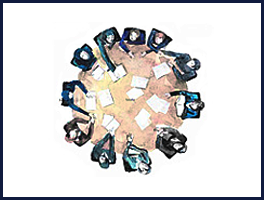How do we make it possible for people to implement the strategy? What do they need? How do we make everything work together well?
There’s no perfect word for this collection of enabling factors, so we’ll use “architecture.” It has many components and facets, as organizations are remarkably complex social systems. To keep it workable, let’s focus on five.
So much has been written and said about organizational culture, much of it useful, all of it together overwhelming. For this purpose, let’s call it the expected and encouraged beliefs and behaviors that enable us to live our values and realize our vision. Culture is tremendously powerful, and some writers about leadership believe that shaping culture is the most powerful tool in a leader’s kit.
Where culture defines the music, structure sets the seating of the orchestra. It enables responsibility for function and task, and defines formal power relationships. A good organizational design starts with strategy and creates structure to enable the delivery of it.
Filling out that structure are, of course, people (staff). Getting them there, keeping them there, having them be productive and focused on the right things is the work of human resources management. This work can be defined as a collection of processes aligned to support the culture and enable the mission/vision/strategy. Perhaps the most critical of those processes are the reward systems, which powerfully communicate and influence priorities and expected behavior.
The work of the organization is done through processes. These range from easily identifiable and highly managed processes such as financial transactions and service requests, to less tangible and traceable processes such as interpersonal communications. Processes provide predictability and stability so that each unpredictable situation can be addressed as an anomaly.
Processes are based in technology. We normally think of this as being about computer based systems, which dominate the tech landscape. However this also includes modes of transportation, machinery, medical instruments, etc. How well technology supports processes is key to an organization’s ability to execute its strategy. In the past, technology would have a subset of processes and not highlighted here, but it has become so important to the brand identity and responsiveness of organizations that it deserves this status.


